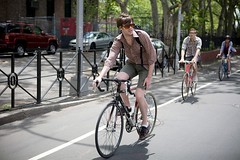The paint and concrete have barely dried on the East Village’s new bicycle lanes, but already business owners and residents are concerned about new dangers for neighborhood cyclists. The new lanes on First and Second Avenue pose a range of potential hazards from open car doors to riders who go against the flow of traffic.
Christopher Feltman, co-manager of the Second Avenue bike shop NYC Velo, estimates that wrong-way bike traffic has increased at least fivefold since the lanes were installed this summer.
“As a rider, I think it’s been worse,” he says of safety on Second Avenue since the lanes were added. “Because they painted it green, a lot of people take that as ‘I can go both ways on it.’”
Feltman goes on to describe a friend who veered to dodge a sudden obstruction and got “doored.” The experience unnerved the rider enough that he called the police on the driver, got into an argument, and kicked the car door – whereupon the officer arrested the cyclist.
So-called dooring can be hazardous; earlier this month, a 23-year-old cyclist in Brooklyn was killed after an open car door forced her into the path of an oncoming bus.
Marco Michelus, co-owner of Crembebé, a children’s boutique on Second Avenue says that he has witnessed a dooring incident and numerous cases of reckless high-speed riding.
Mr. Michelus uses bike lanes daily himself, and while he says that he is grateful to transportation officials for the lanes, he is under no illusions that they have brought civility to the streets overnight.
“I think the bikers have to be a little bit more cautious,” he says.
Harry Powell, manager of Mary Ann’s restaurant on Second Avenue near East Fifth Street, rode as a bike messenger in his youth but now describes himself as an ex-cyclist who admires the city’s efforts to reduce auto traffic.
He says that he has endured repeated close brushes with wrong-way cyclists and is one of several merchants who identify wrong-way or upstream riders, a.k.a. “salmon,” as a special menace. (Riding salmon-style against one-way traffic is illegal.)
 Emily Anne Epstein The owner of a local bike shop estimates that wrong-way traffic by cyclists has increased fivefold.
Emily Anne Epstein The owner of a local bike shop estimates that wrong-way traffic by cyclists has increased fivefold.Those are precisely the kinds of incidents that the new lanes were designed to prevent. After a 2008 pilot project reshaping segments of Eighth and Ninth Avenues cut accident rates sharply, the Department of Transportation initiated similar changes on First and Second Avenues this summer.
For First and Second to match the safety results on Eighth and Ninth, the redesign may need better signage, coordination with law enforcement and public education to accompany the targeted outreach that transportation officials have made to children and those who are 65 and older.
Above Houston Street, First and Second Avenues have undergone a curb-to-curb redesign as parking-protected lanes: each avenue’s left-side parking lane has been shifted towards the street to create a curbside bike lane. This bike lane is separated from motorized traffic and buffered by the new “floating lane” of parked cars, plus concrete and pedestrian islands added at some intersections.
Mr. Feltman speculates that the new lanes will bring safety benefits only when all parties learn to use them appropriately.
“I think eventually, when people stop walking into it …” he begins – and outside his window, a pedestrian then obligingly completes his point by illustrating it, wandering aimlessly into the green paint, cell phone to ear, distracted and vulnerable.




